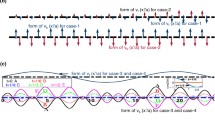Abstract
Heat-transfer characteristics of mixed electro-osmotic and pressure-driven flows are obtained in a two-dimensional straight microchannel by a solving steady-state energy equation. Both thermally developing and fully developed regions are considered for hydraulically fully developed mixed flows under isoflux channel wall conditions. The steady temperature distribution is obtained from the superposition of homogeneous solution and particular function. The particular solution is derived based on the constant heat-flux condition in the fully developed region, while the homogeneous solution is presented in terms of infinite series containing Kummer confluent hypergeometric functions due to the existence of non-self-adjoint eigenvalues. The coefficients of the homogeneous solution are found by utilizing the Gram-Schmidt orthogonalization procedure, and the Secant method is utilized to obtain the corresponding eigenvalues. Our analytical techniques are verified by obtaining an excellent agreement with existing literature for slug, pressure-driven, and pure electroosmotic flow cases. In the fully developed region, the Nusselt number of mixed flow is independent of the thermal Peclet number for a particular Joule heating and imposed surface heat flux. The entry length of mixed flow significantly depends on the applied/induced pressure gradient to the electro-osmotic flow
Similar content being viewed by others
References
Kutter J.P. (2000). Current developments in electrophoretic and chromatographic separation methods on microfabricated devices. Trac-Trends in Analyt. Chem. 19:352–363
Yang J., Li C.W., Yang M.S. (2002). Lab-on-a-chip (microfluidics) technology. Acta Bioch. Biop. Sin. 34: 117–123
Verpoorte E. (2002). Microfluidic chips for clinical and forensic analysis. Electrophoresis 23:677–712
Cui H., Keisuke H., Dutta P., Ivory C.F. (2005). Isoelectric focusing in a poly(dimethylsiloxane) microfluidic chip. Analyt. Chem. 77:1303–1309
Selvaganapathy P., Ki Y.S.L., Renaud P., Mastrangelo C.H. (2002). Bubble-free electrokinetic pumping. J. Microelectromech. Syst. 11:448–453
Probstein R.F. (1994). Physiochemical Hydrodynamics Second ed. Wiley and Sons, New York 400 pp.
Chen C.H., Santiago J.G. (2002). A planar electro-osmotic micropump. J. Microelectromech. Syst. 11:672–683
Tripp J.A., Svec F., Fechet J.M.J., Zeng S.L., Mikkelsen J.C., Santiago J.G. (2004). High-pressure electro-osmotic pumps based on porous polymer monoliths. Sensors Actuat. B 99:66–73
Fan Z., Harrison D.J. (1994). Micromachining of capillary electrophoresis injectors and separators on glass chips and evaluation of flow at capillary intersections. Analyt. Chem. 66:177–184
Ermakov S.V., Jacobson S.C., Ramsey J.M. (1998). Computer simulations of electrokinetic transport in microfabricated channel structures. Analyt. Chem. 70:4494–4504
Jacobson S.C., Culbertson C.T., Daler J.E., Ramsey J.M. (1998). Microchip structures for submillisecond electrophoresis. Analyt. Chem. 70:3476–3480
Swinney K., Bornhop D.J. (2002). Quantification and evaluation of Joule heating in on-chip capillary electrophoresis. Electrophoresis 23:613–620
Burgi D.S., Salomon K., Chien R.L. (1991). Methods for calculating the internal temperature of capillary columns during capillary electrophoresis. J. Liq. Chromatogr. 14:847–867
Maynes D., Webb B.W. (2003). Fully developed electro-osmotic heat transfer in microchannels. Int. J. Heat Mass Transfer 46:1359–1369
Maynes D., Webb B.W. (2003). Fully-developed thermal transport in combined pressure and electro-osmotically driven flow in microchannels. J. Heat Transfer Trans. ASME 125:889–895
Ross D., Locascio L.E. (2002). Microfluidic temperature gradient focusing. Analyt. Chem. 74:2556–2564
Graetz L. (1883). Ueber die Wärmeleitungsfähigkeit von Flüssigkeiten (Erste Abhandlumg). Ann. Phys. Chem. 18:78–94
Agrawal H.C. (1960). Heat transfer in laminar flow between parallel plates at small Peclet numbers. Appl. Sci. Res. A9:177–189
Hsu C.J. (1971). An exact analysis of low Peclet number thermal entry region heat transfer in transversally nonuniform velocity fields. AIChE J. 17:732–740
Michelsen M.L., Villadsen J.(1974). The Graetz problem with axial heat conduction. Int. J. Heat Mass Transfer 17:1391–1402
Papoutsakis E., Ramkrishna D., Lim H.C. (1980). The extended Graetz problem with prescribed wall flux. AIChE J. 26:779–787
Lahjomri J., Oubarra A. (1999). Analytical solution of the Graetz problem with axial conduction. J. Heat Transfer Trans. ASME 121:1078–1083
Telles A.S., Querioz E.M., Filho G.E. (2001). Solution of the extended Graetz problem. Int. J. Heat Mass Transfer 44:471–483
Weigand B., Kanzamar M., Beer H. (2001). The extended Graetz problem with piecewise constant wall heat flux for pipe and channel flows. Int. J. Heat Mass Transfer 44:3941–3952
Lahjomri J., Zniber K., Oubarra A., Alemany A. (2003). Heat transfer by laminar Hartmann’s flow in thermal entrance region with uniform wall heat flux: the Graetz problem extended. Energy Conv. Manag. 44:11–34
Sparrow E.M., Novotny J.L., Lin S.H. (1963). Laminar flow of a heat-generating fluid in a parallel-plate channel. AIChE J. 9:797–804
Horiuchi K., Dutta P. (2004). Joule heating effects in electroosmotically driven microchannel flows. Int. J. Heat Mass Transfer 47:3085–3095
Dutta P., Beskok A. (2001). Analytical solution of combined electroosmotic/pressure driven flows in two-dimensional straight channels: finite debye layer effects. Analyt. Chem. 73:1979–1986
Lyklema J., Rovillard S., De Coninck J. (1998). Electrokinetics: the properties of the stagnant layer unraveled. ACS J. Surf. Colloids 14:5659–5663
Arfken G. (1985). Mathematical Methods for Physicists Third ed. Academic Press, Boca Raton, FL 815 pp.
31. Burmeister L.C. (1994). Convective Heat Transfer. Wiley and Sons, New York 790 pp.
Cess R.D., Shaffer E.C. (1959). Heat transfer to laminar flow between parallel plates with a prescribed wall heat flux. Appl. Sci. Res. A8:339–344
Author information
Authors and Affiliations
Corresponding author
Rights and permissions
About this article
Cite this article
Horiuchi, K., Dutta, P. & Hossain, A. Joule-heating effects in mixed electroosmotic and pressure-driven microflows under constant wall heat flux. J Eng Math 54, 159–180 (2006). https://doi.org/10.1007/s10665-005-9019-9
Received:
Accepted:
Published:
Issue Date:
DOI: https://doi.org/10.1007/s10665-005-9019-9




